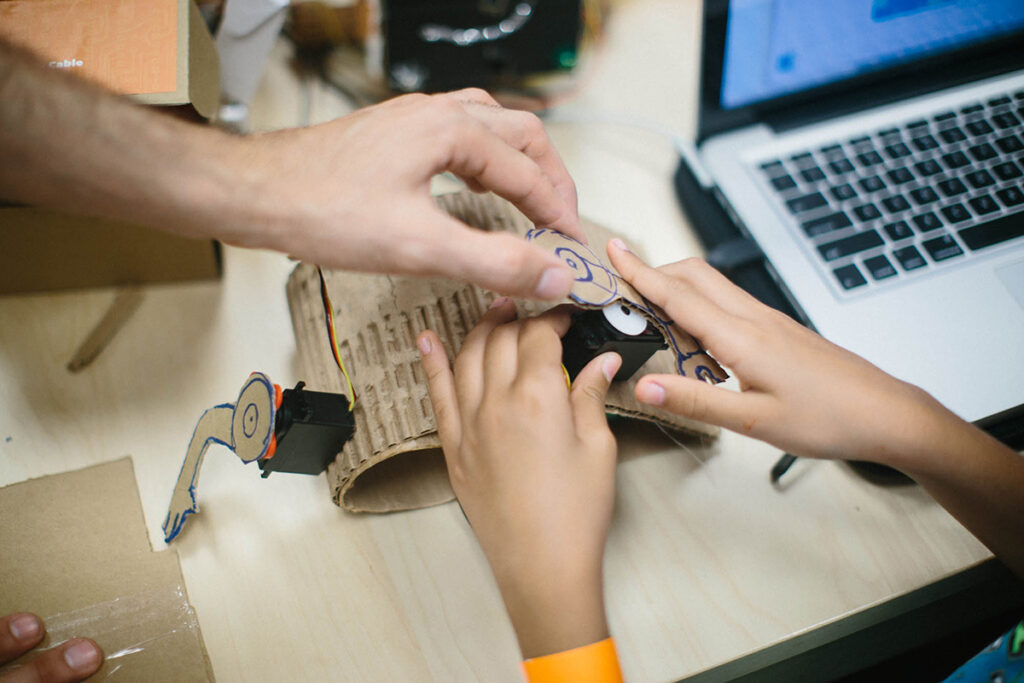Seems everyone is a cheerleader for the maker movement these days, from President Obama to the Pittsburgh Pirates. Who isn’t in favor of more self-directed, hands-on learning projects; cupcake cars; or kids working with old-fashioned looms?
That’s why—for a lot of maker-oriented folks browsing the internet late last January—Debbie Chachra’s “Why I Am Not a Maker” in the Atlantic made them do a Twitter-scroll double take. It certainly did for me.
“An identity built around making things—of being ‘a maker’—pervades technology culture,” she wrote. “There’s a widespread idea that ‘People who make things are simply different [read: better] than those who don’t.’”
As Chachra, who is an associate professor at the Olin College of Engineering, went on to explain, placing such high value on making things isn’t only buying into an overtly capitalistic mindset—it’s carrying on a gendered history of prioritizing creation of stuff over occupations like caretaking or education, roles historically taken by women.
She also points to the peculiarity that coding has been folded so seamlessly into the maker movement. She attests that’s because we’ve figured out how to sell code—and it’s perceived to be done mainly by men. Meanwhile, teaching and caregiving, traditionally women’s work, isn’t considered part of the “maker” domain.
“Making is not a rebel movement, scrappy individuals going up against the system,” she wrote. “While the shift might be from the corporate to the individual (supported, mind, by a different set of companies selling a different set of things), it mostly re-inscribes familiar values, in slightly different form: that artifacts are important, and people are not.”
Cue the mental tire screech-sound effect at that one.
Although Chachra’s piece may be controversial, as far as I can tell, the general reaction on social media seemed to be an appreciation for her thoughtful critique. People all around the web—maker advocates or not—called it “challenging” or “thought provoking.” She does not hold back. And because so much coverage routinely hails the maker movement as the greatest thing since sliced bread, something that looks at it from a skeptical angle is refreshing to hear.
Of course, the piece elicited response from many who do consider themselves makers, often very proudly. At DML Central, educational researcher Nicole Mirra took Chachra’s critiques one by one.
“Couldn’t we instead proudly embrace our multiple identities and work to draw out the connections between them—the ways that we cannot fully realize our potential as makers until we work on cultivating the crucial caring virtues of listening, empathizing, and loving?” Mirra wrote.
Meanwhile, blogger and the chair of computer science at the Baldwin School, Laura Blankenship, noted that the maker movement arose from our existing culture, meaning it brings with it cultural sexism, racism, and classism. But similar to Mirra’s articulations, Blankenship thinks it’s worth trying to change the movement from within.
“The maker movement deserves our critical eye, for sure, but it should be changed and not rejected,” she wrote. “Its focus can’t be on what makes white, middle aged men happy—robots, cool gadgets, cars—but we need to point out when this is happening and correct it.”
As Mirra pointed out in the beginning of her post, there does seem to be a gap in definitions. Although she doesn’t explain it, Chachra’s maker movement seems to focus in on techie, Silicon Valley start-up culture that builds the types of things that could be sold or, at the very least, shown off. But in schools and informal learning spaces, it’s the wondrously frustrating process of making that’s valued—the result of a catapult or a sword or circuit is really only a bonus. Many would likely argue there is no “adult” maker movement and educational maker movement but that it’s one and the same. However, there does seem to be a difference in definitions between what Chachra has experienced and what goes on day in and day out in makerspaces built for kids and their families.
A dialogue on making can’t be a bad thing, though. Along with recognition, at this point the maker movement has gained a key ingredient to any thing that’s ever made an impact: healthy critique.
